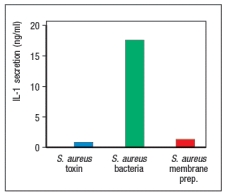Dendritic cells in the skin, known as Langerhans cells, express very high levels of the NOD-like receptor, NLRP3. Previous studies showed that treatment of these cells with the Staphylococcus aureus pore-forming toxin causes K+ efflux from the cells. To investigate whether this signal could induce IL-1 (an inflammatory cytokine) secretion by the cells, the following study was performed: 
The explanation for these results is:
A) NLRP3 is not activated by K+ efflux from the cells.
B) The S. aureus toxin does not kill the Langerhans cells.
C) The live S. aureus bacteria activate a TLR and NLRP3.
D) The S. aureus membrane prep does not contain a TLR ligand.
E) TLR activation by S. aureus membranes induces interferon production.
Correct Answer:
Verified
Q1: Dendritic cells are tissue resident myeloid cells
Q2: All mammalian TLRs have been shown to
Q3: An infection in the skin, such as
Q5: A key feature of TLR signaling is
Q6: NOD1 and NOD2 are cytoplasmic sensors of
Q7: In recent years, several new vaccines have
Q8: When stimulated by binding to bacterial
Q9: Many different NOD-like receptors, including several with
Q10: Mycobacteria are intracellular pathogens that have adapted
Q11: RIG-I like receptors (RLRs) such as RIG-I,
Unlock this Answer For Free Now!
View this answer and more for free by performing one of the following actions

Scan the QR code to install the App and get 2 free unlocks

Unlock quizzes for free by uploading documents